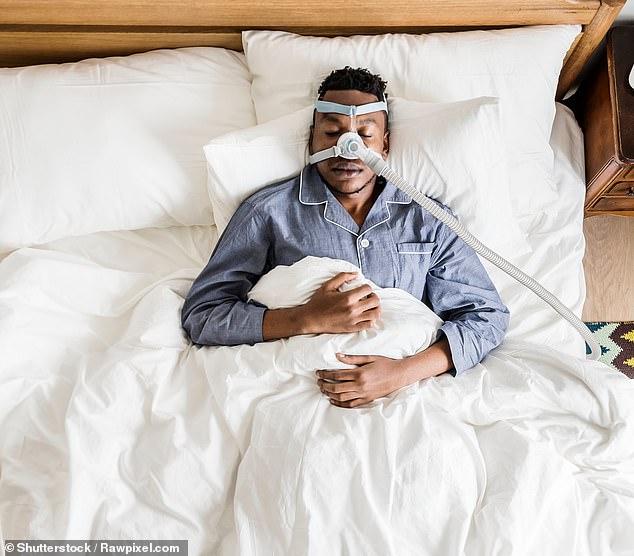The Deadly Thing You Do in Your Sleep – One in five Americans has a potentially fatal sleep disorder and most don’t know it
One in five Americans has a potentially fatal sleep disorder that causes breathing to stop, potentially cutting off oxygen supply to the brain.
Sleep apnea is a common sleep-related condition in which breathing stops and starts again during the night, putting the body at risk of dangerously depriving it of essential oxygen.
Patients snore, choke and gasp during the night, 20 to 30 times an hour, and as a result wake up unconsciously and repeatedly, meaning the body is not getting enough rest.
While some people may not even realize they have the condition, others are alerted by their partners, who tell them they are gasping for breath during sleep. A test to diagnose sleep apnea is also usually performed, in which a person is connected to equipment that monitors breathing patterns and blood oxygen levels while they sleep.
When breathing stops for 10 seconds or more at a time, oxygen levels in the blood drop, increasing the risk of hypertension, stroke and heart attacks over time.
As part of the treatment of sleep apnea, pPatients often need to wear a device called a continuous positive airway pressure machine (or CPAP machine) while they sleep.
About 18 million Americans have been diagnosed with the condition, including President Joe Biden.
In June, the White House revealed that Biden, 80, had started using a CPAP machine to treat his sleep apnea after he was noticed with visible indentations on his face that many speculated came from the machine.
The lines on President Joe Biden’s face in June prompted the White House to tell reporters that he had started using a CPAP machine

CPAP masks come in different styles and sizes to accommodate different preferences and facial structures. The locations of the lines on President Biden’s face suggest he is using a full face mask as pictured above
The machine provides a constant flow of compressed air into the nose and mouth and keeps the airways open to optimize breathing during sleep.
a study published Tuesday in JAMA found that consistent use of a CPAP machine protects against cardiovascular disease in high-risk individuals — something that is much debated.
It turned out that using the CPAP machine for more than four hours during sleep reduces the risk of stroke, heart attack or cardiac arrest.
Although loud and intermittent snoring is a common sign of the condition, not all people with sleep apnea snore. However, if the snoring is interrupted by abrupt pauses in breathing and attacks of choking or gasping during sleep, as well as excessive daytime sleepiness, difficulty concentrating and high blood pressure, this may indicate obstructive sleep apnea (OSA).
OSA is the most common form of sleep apnea, affecting an estimated one in five American adults, although many cases go undiagnosed.
People with severe OSAwho wake up more than 30 times per hour and are at increased risk of death from any cause, which could shorten their lives by up to ten years.
People with moderate OSA, who wake up between 15 and 30 times per hour, are 72 percent more likely to die.
The higher risk of heart attacks and strokes for people with sleep apnea is the main cause of the increased mortality risk.
Another type of sleep apnea is central sleep apnea, which occurs when the brain doesn’t send the signals needed to breathe.
Overall, men are two to three times more likely to have sleep apnea than women, although obesity and old age are the biggest risk factors.
The condition occurs when the muscles that support the throat relax and the airways narrow and collapse, meaning air cannot flow in or out of the nose or mouth.
When this happens, breathing may stop for 10 seconds or more at a time until the reflexes kick in and breathing returns to the proper rate, often without the person realizing anything has happened, although upon waking he/she You may notice a pattern of dry mouth and persistent fatigue. .
Trying to breathe against a collapsed airway ultimately deprives the body of crucial oxygen.
While normal blood oxygenation levels fluctuates around 90 to 95 percentan apnea sleeper can see these levels drop into the 80s and even 70s.
Oxygen saturation levels normally return to normal once breathing resumes, but for a person with OSA who breathes irregularly throughout the night, permanent damage to health can occur.
For example, frequent drops in blood oxygen concentrations have been shown to increase blood pressure, increasing the risk of hypertension.
In fact, high blood pressure and sleep apnea go hand in hand. About 30 to 40 percent of people with sleep apnea have hypertension, and OSA can worsen high blood pressure.
People with OSA are also more susceptible to heart attacks. The American Thoracic Association reports that people with untreated sleep apnea are twice as likely to have a heart attack later in life as people without OSA.
Of all Americans hospitalized for coronary artery disease — a condition characterized by a buildup of cholesterol in the arteries that narrows the blood vessels and blocks the flow of oxygen-rich blood to the heart — 70 percent have been diagnosed with OSA.
Older people are more likely to have sleep apnea. The older a person is, the more serious the consequences of sleep apnea can be, as research shows that the condition dramatically increases the risks associated with age-related cardiovascular changes, such as a higher risk of heart attack.
